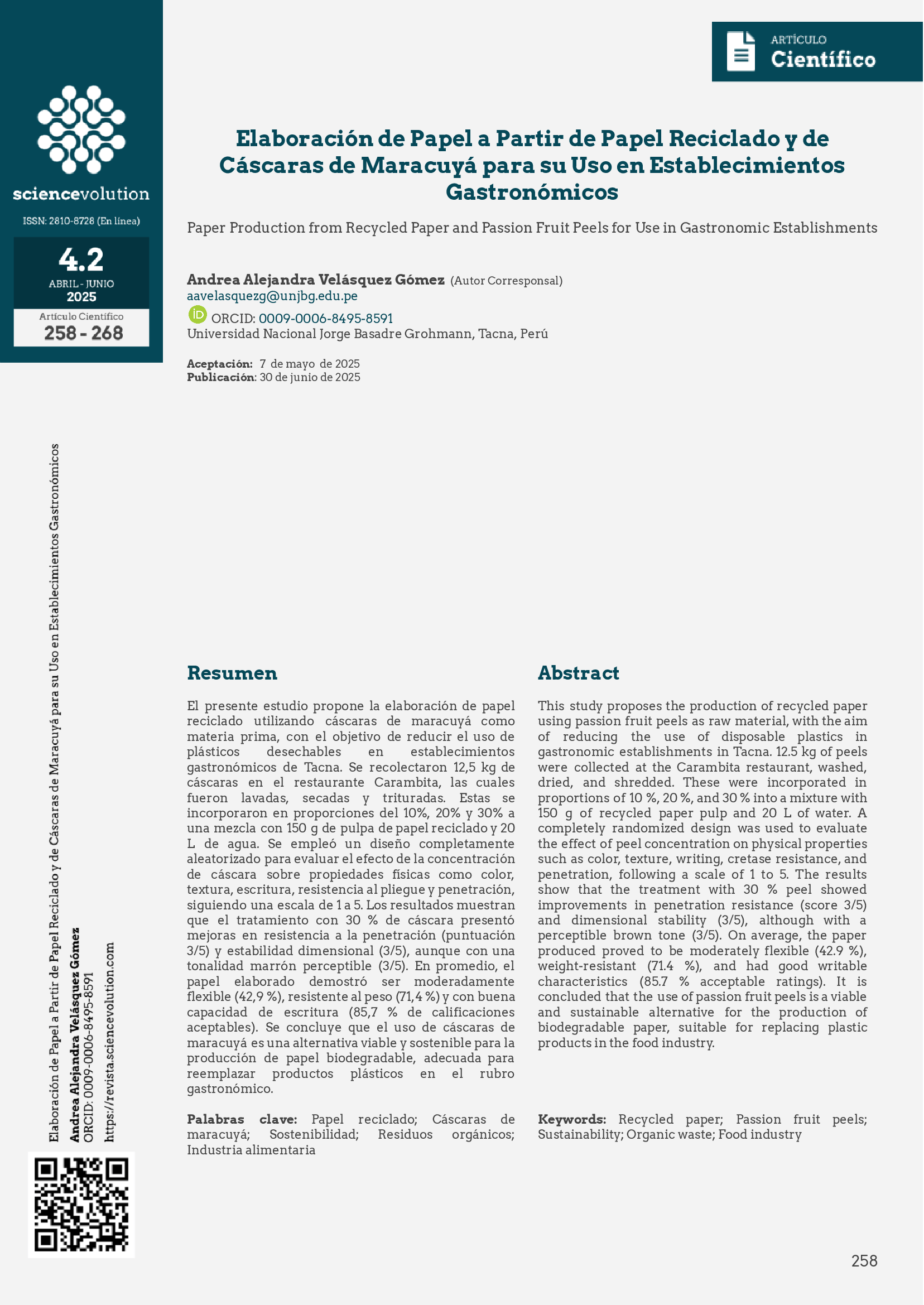Abstract
This study proposes the production of recycled paper using passion fruit peels as raw material, with the aim of reducing the use of disposable plastics in gastronomic establishments in Tacna. 12.5 kg of peels were collected at the Carambita restaurant, washed, dried, and shredded. These were incorporated in proportions of 10 %, 20 %, and 30 % into a mixture with 150 g of recycled paper pulp and 20 L of water. A completely randomized design was used to evaluate the effect of peel concentration on physical properties such as color, texture, writing, cretase resistance, and penetration, following a scale of 1 to 5. The results show that the treatment with 30 % peel showed improvements in penetration resistance (score 3/5) and dimensional stability (3/5), although with a perceptible brown tone (3/5). On average, the paper produced proved to be moderately flexible (42.9 %), weight-resistant (71.4 %), and had good writable characteristics (85.7 % acceptable ratings). It is concluded that the use of passion fruit peels is a viable and sustainable alternative for the production of biodegradable paper, suitable for replacing plastic products in the food industry.
References
Cabezas, W., Dávila, D., Freire, C., Hernández, S., & Morales, A. (2022). Elaboración de papel a base del banano. Athenea Journal in Engineering Sciences, 2(6), 15–21. https://doi.org/10.47460/athenea.v2i6.29
Carvalho Pereira, Z., Martins dos Anjos Cruz, J. M., Frota Corrêa, R., Aparecido Sanches, E., Campelo, P. H., & de Araújo Bezerra, J. (2023). Passion fruit (Passiflora spp.) pulp: A review on bioactive properties, health benefits and technological potential. Food Research International, 166, 112626. https://doi.org/10.1016/j.foodres.2023.112626
Cheng, Z., Li, J., He, G., Su, M., Xiao, N., Zhang, X., Zhong, L., Wang, H., Zhong, Y., Chen, Q., Chen, Y., & Liu, M. (2024). Biodegradable packaging paper derived from chitosan-based composite barrier coating for agricultural products preservation. International Journal of Biological Macromolecules, 280(4), 136112. https://doi.org/10.1016/j.ijbiomac.2024.136112
ComexPerú. (2022). Solo aprovechamos el 1% de residuos orgánicos e inorgánicos que generamos. https://www.comexperu.org.pe/articulo/solo-aprovechamos-el-1-de-residuos-organicos-e-inorganicos-que-generamos
Dalgo-Flores, V. M., Cayambe Criollo, J. D., Rodríguez Vinueza, V. I., Tixi Gallegos, K. G., & Quispillo Moyota, J. M. (2024). Caracterización físico-química en la optimización de la producción de pectina a partir de residuos de naranja (Citrus sinensis) mediante hidrólisis ácida: Un enfoque eficiente para su potencial aplicación como agente estabilizante, emulsificante y gelificante. Dialnet, 9(1), 2041-2064. https://dialnet.unirioja.es/servlet/articulo?codigo=9281996
Do Val Siqueira, L., Arias, C. I. L. F., Maniglia, B. C., & Tadini, C. C. (2021). Starch-based biodegradable plastics: methods of production, challenges and future perspectives. Current Opinion in Food Science, 38, 122–130. https://doi.org/10.1016/j.cofs.2020.10.020
Haile, A., Gelebo, G. G., Tesfaye, T., Mengie, W., Mebrate, M. A., Abuhay, A., & Limeneh, D. Y. (2021). Pulp and paper mill wastes: utilizations and prospects for high value-added biomaterials. Bioresources and Bioprocessing, 8(35), 35. https://doi.org/10.1186/s40643-021-00385-3
Jurado-Erazo, D. K., Tulcán-Cuasapud, Y. A., & Rojas González, A. F. (2023). Perspectivas de valorización de residuos de frutas a partir de sus características físicas. Ciencia y Tecnología Agropecuaria, 24(1), e3016. https://doi.org/10.21930/rcta.vol24_num1_art:3016
Manea, E. E., Bumbac, C., Dinu, L. R., Bumbac, M., & Nicolescu, C. M. (2024). Composting as a sustainable solution for organic solid waste management: Current practices and potential improvements. Sustainability, 16(15), 6329. https://doi.org/10.3390/su16156329
Ministerio del Ambiente#. (2021). Resolución Ministerial N.º 105‑2021‑MINAM: Aprueban tres fichas de homologación de “Papel bond A3 y A4”. El Peruano. https://www.gob.pe/institucion/minam/normas-legales/1985755-105-2021-minam
Moreno, F. A., Robayo Quintana, M., Ferrucho Rodríguez, L., & Vargas Oyola, M. (2016). Aprovechamiento de residuos vegetales de pétalos de rosas, tallos de girasol y vástago de plátano para la fabricación artesanal de papel. Inventum, 11(20), 71–82. https://doi.org/10.26620/uniminuto.inventum.11.20.2016.71-82
Organización de las Naciones Unidas. (2015). Objetivos de Desarrollo Sostenible. https://www.un.org/sustainabledevelopment/es/objetivos-de-desarrollo-sostenible/
Orrego, C. E., Salgado, N., & Díaz, M. S. (2020). Productividad y competitividad frutícola andina: Producto 9. Estudio de mercado interno y externo de la fruta fresca y sus derivados [Informe técnico]. FONTAGRO. https://www.fontagro.org/new/uploads/productos/16111_-_Producto_9.pdf
Programa de las Naciones Unidas. (2021). El plástico, que ya ha atragantado nuestros océanos, terminará por asfixiarnos a todos si no actuamos rápidamente. https://news.un.org/es/story/2021/10/1498752
Programa de las Naciones Unidas- Habitat. (s.f.). Recolectar y eliminar residuos de manera eficiente. Recuperado el 20 de mayo de 2025 https://onu-habitat.org/index.php/recolectar-y-eliminar-residuos-de-manera-eficiente
Sistema Nacional de Información Ambiental. (2021). Reporte estadístico departamental 2021: Tacna. Ministerio del Ambiente. https://sinia.minam.gob.pe/sites/default/files/sinia/archivos/public/docs/dossier_tacna_ago21.pdf
Worku, L. A., Bachheti, A., Bachheti, R. K., Rodrigues Reis, C. E., & Chandel, A. K. (2023). Agricultural residues as raw materials for pulp and paper production: Overview and applications on membrane fabrication. Membranes, 13(2), 228. https://doi.org/10.3390/membranes13020228
Zhao, L., Huang, H., Han, Q., Yu, Q., Lin, P., Huang, S., Yin, X., Yang, F., Zhan, J., Wang, H., & Wang, L. (2020). A novel approach to fabricate fully biodegradable poly(butylene succinate) biocomposites using a paper-manufacturing and compression molding method. Composites Part A: Applied Science and Manufacturing, 139, 106117. https://doi.org/10.1016/j.compositesa.2020.106117

This work is licensed under a Creative Commons Attribution-NonCommercial-NoDerivatives 4.0 International License.

